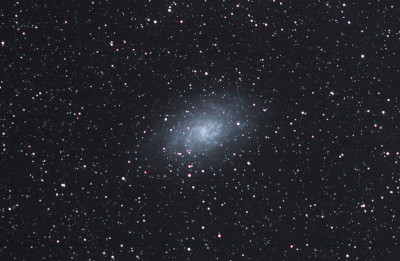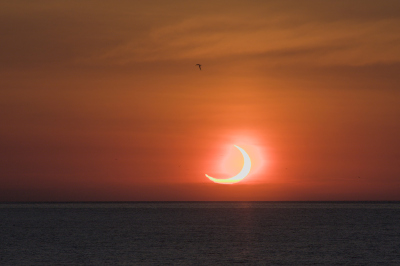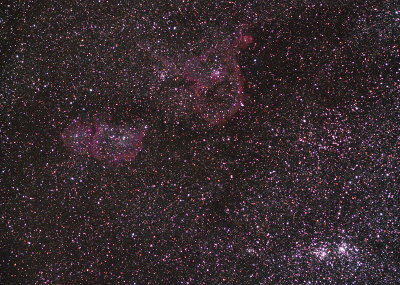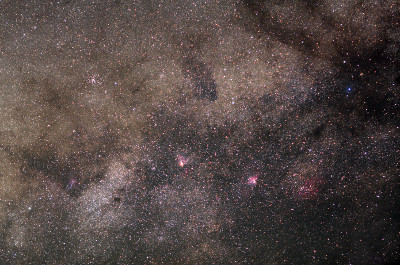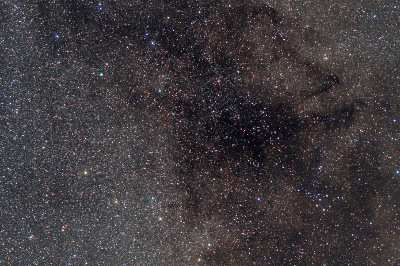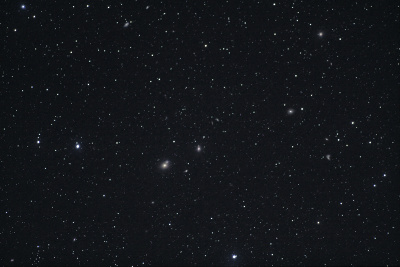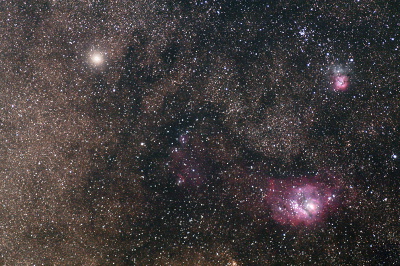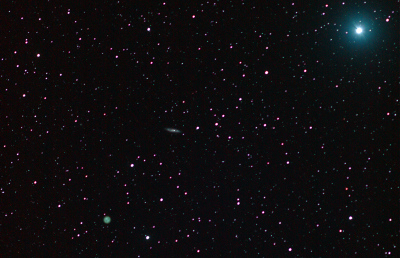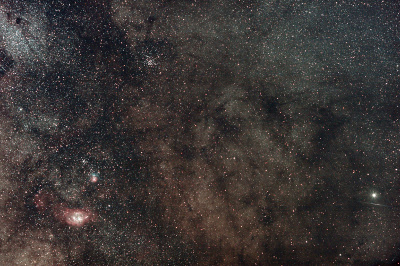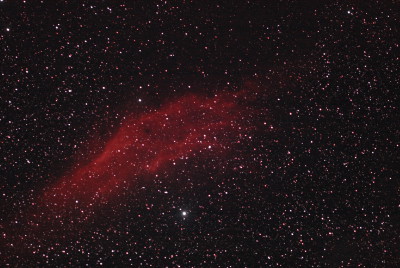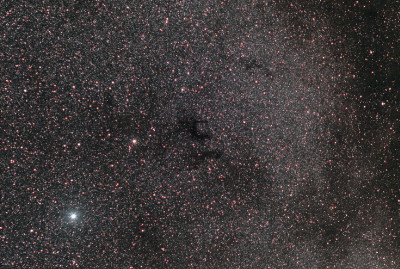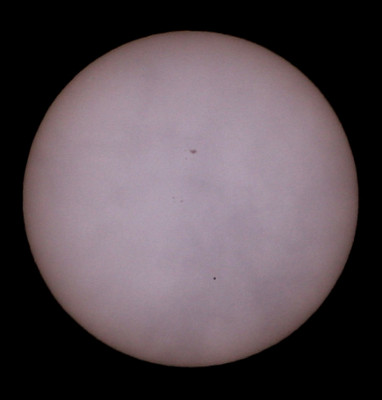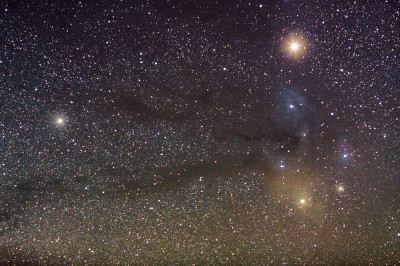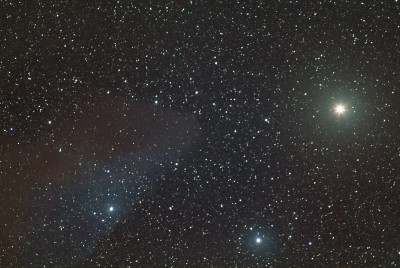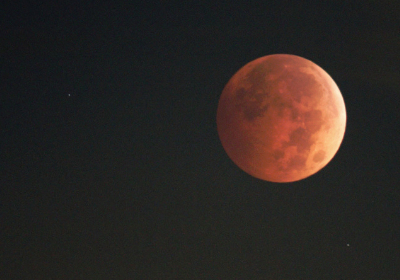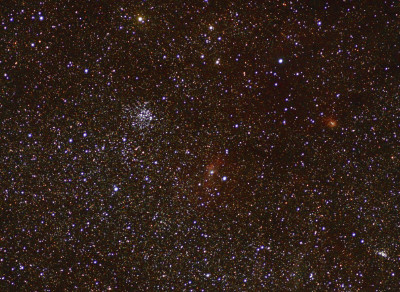| HOME | COMET GALLERY | LEGACY ASTRO-GALLERY | LINKS |
| FEEL FREE TO E-MAIL ME: [ bxmas "AT" interlynx.net ] | |||
B o b C h r i s t m a s ' D i g i t a l A s t r o p h o t o G a l l e r y
Welcome to my digital astrophotography gallery!
I took these astrophotos with the following equipment:
--- Canon 40D DSLR camera
--- Tamron 300mm f/2.8 telephoto lens
--- Canon 100mm f/2.0 telephoto lens
Except for the Mercury Transit image and the Eclipse images, all of these were taken with the lens and camera mounted on a Super Polaris equatorial mount, with its axis of rotation pointed at the north pole of the sky. The mount is equipped with an electrically-driven clock drive, whose purpose is to automatically track the stars in the sky, thus compensating for the Earth's rotation. This prevents the "trailing" of the stars on such images.
Most of these images were taken from Spectacle
Lake Lodge near Barry's Bay,
Many of these images are composite ("stacked") images, combined into single images using Deep Sky Stacker. Most are full-frame, but some are cropped and magnified.
Images are listed mostly in reverse chronological order.
All images Copyright ©, by Bob Christmas
Click on any image for a bigger view. Then (if necessary) click again on bigger-view image to get full-size.
|
M33, the Triangulum Galaxy
Location in Sky: Triangulum Location on Earth: Barry's Bay, Ontario Camera: Canon 40D DSLR with an Astronomik CLS clip filter Lens: Tamron 300mm f/2.8 Settings: f/2.8, ISO 1600 Exposures: 40 x 90 seconds; 60 minutes total
Crop of original image. North is to the left. |
|
|
Partial Solar Eclipse over Lake Ontario
Location on Earth: Burlington, Ontario Camera: Canon 40D DSLR Lens: Tamron 300mm Settings: f/11, ISO 100 Exposure: 1/125 second |
|
|
The Heart and Soul Nebulas, and the Perseus Double-Cluster
Top: the Heart Nebula (IC 1795/1805); Left: the Soul Nebula (IC 1848); Bottom right: the Perseus Double-Cluster (NGC 884/869).
Crop of original image.
Location in Sky: Eastern Cassiopeia / Northern Perseus Location on Earth: Barry's Bay, Ontario Camera: Canon 40D DSLR Lens: Canon 100mm telephoto lens Settings: f/2.8, ISO 800 Exposures: 15 x 2 minutes; 30 minutes total |
|
|
Summer Milky Way Dust Clouds and Nebulas
This image includes (bottom left to right) the star cloud M24, the Swan (Omega) Nebula (M17), and the Eagle Nebula (M16). Near upper left is open star cluster M25. Just to the right of M25 is smaller open cluster NGC 6645. Also visible are numerous opaque dust clouds, or dark nebulas, many of them with Barnard designations.
North is to the right.
Location in Sky: Southern Sagittarius, SW Scutum and SE Serpens Cauda Location on Earth: Barry's Bay, Ontario Camera: Canon 40D DSLR Lens: Canon 100mm telephoto lens Settings: f/2.8, ISO 800 Exposures: 9 x 2 minutes; 18 minutes total |
|
|
The Dumbbell and the Coathanger
The Dumbbell Nebula (M27) is near upper left; the "Coathanger" star cluster (Cr 399) is near lower right.
Location in Sky: Sagitta and Vulpecula Location on Earth: Barry's Bay, Ontario Camera: Canon 40D DSLR Lens: Canon 100mm telephoto lens Settings: f/2.8, ISO 800 Exposures: 10 x 2 minutes; 20 minutes total |
|
|
The M60 Area of the Virgo Galaxy Cluster
The four brightest of numerous galaxies in this part of the Virgo Galaxy Cluster are, from upper right towards lower left are M89, M58, M59 and M60.
Location in Sky: Virgo Location on Earth: Barry's Bay, Ontario Camera: Canon 40D DSLR Lens: Tamron 300mm f/2.8 Settings: f/2.8, ISO 800 Exposures: 26 x 90 secs; 39 minutes total |
|
|
Saturn, M8 and M20
Saturn, upper left, was beside the Lagoon Nebula (M8; lower right) and the Trifid Nebula (M20; upper right).
Location in Sky: Sagittarius Location on Earth: Barry's Bay, Ontario Camera: Canon 40D DSLR Lens: Tamron 300mm f/2.8 Settings: f/2.8, ISO 800 Exposures: 6 x 85 secs; 8 minutes 30 secs total |
|
|
Merak, M108 and M97
Upper right to lower left are Merak, a star in the bowl of the Big Dipper, Galaxy M108, and the round ghostly planetary nebula M97, The Owl Nebula. Taken with my Canon 40D camera with an Astronomik CLS clip filter. Crop of original full-frame image. Location in Sky: Ursa Major Location on Earth: Barry's Bay, Ontario Lens: Tamron 300mm f/2.8 Settings: f/2.8, ISO 1600 Exposures: 16 x 91 secs; 24 minutes 16 secs total |
|
|
Saturn and M22
Saturn was less than 2 degrees north of the bright globular cluster M22, which is at right in this image.
Location in Sky: Sagittarius Location on Earth: Barry's Bay, Ontario Lens: Tamron 300mm f/2.8 Settings: f/2.8, ISO 1600 Exposures: 10 x 91 secs; 15 minutes 10 secs total |
|
|
Saturn, with M8, M20, M21, M23 and Part of M24
Saturn, and a suspected meteor, is at lower right. Appearing from bottom left to top left are M8 (Lagoon Nebula), M20 (Trifid Nebula), M21 (open cluster), M23 (open cluster) and part of star cloud M24.
Location in Sky: Ophiuchus at right, Sagittarius at left Location on Earth: Barry's Bay, Ontario Lens: Canon 100mm telephoto lens Settings: f/2.8, ISO 1600 Exposures: 13 x 121 secs; 26 minutes 13 secs total |
|
|
NGC 1499, the California Nebula
Taken with my Canon 40D camera with an Astronomik CLS clip filter.
Location in Sky: Perseus Location on Earth: Barry's Bay, Ontario Lens: Tamron 300mm f/2.8 Settings: f/2.8, ISO 1600 Exposures: 21 x 90 secs; 31.5 minutes total |
|
|
Altair, Barnard 142, Barnard 143, and the Aquila Milky Way
This is a tiny portion of the summer Milky Way, centered on the dark nebulae B142 and B143, known as Barnard's "E". At lower left is the bright star Altair (Alpha Aquilae). At upper right, part of the great dark rift in the summer Milky Way is shown. Crop of original image.
Location in Sky: Aquila Location on Earth: Barry's Bay, Ontario Lens: Canon 100mm telephoto lens Settings: f/2.8, ISO 1600 Exposures: 11 x 2 min; 22 minutes total |
|
|
Transit of Mercury, May 9, 2016, 12:23 pm
Mercury is the tiny dot about a quarter of the way up from the bottom of the Sun's disk.
Location on Earth: Burlington, Ontario Lens: Tamron 300mm f/2.8, with Baader solar filter Settings: f/11, ISO 100 Exposure: 1/400 second |
|
|
Mars, Saturn & Antares, May 2, 2016, ~12:45 am
Mars is at upper right, Saturn is at left, and Antares is near lower right, beside globular cluster M4. Numerous nebulas and dust lanes are also visible.
Location in Sky: The Scorpius / Ophiuchus border Location on Earth: Barry's Bay, Ontario Lens: Canon 100mm telephoto lens Settings: f/2.8, ISO 1600 Exposures: 14 x 1 min; 14 minutes total |
|
|
IC 5146, the Cocoon Nebula, and Open Cluster NGC 7209, October 7, 2015
IC 5146, the Cocoon Nebula is near upper right, with dark nebula Barnard 168 trailing away from it. Open star cluster NGC 7209 is near lower left.
Taken with my Canon 40D camera with an Astronomik CLS clip filter.
Location in Sky: The Cygnus / Lacerta border Location on Earth: Barry's Bay, Ontario Lens: Tamron 300mm f/2.8 Settings: f/2.8, ISO 1600 Exposures: 20 x 90 secs; 30 minutes total |
|
|
Saturn and IC 4592, May 13, 2015
Saturn, about 9 days before opposition, is at right, and part of the reflection nebula IC 4592, the Blue Horsehead, is at left.
Location in Sky: The Libra / Scorpius border Location on Earth: Barry's Bay, Ontario Lens: Tamron 300mm f/2.8 Settings: f/2.8, ISO 1600 Exposures: 10 x 90 secs (15 minutes) with a single 60 second f/4 frame masked and blended in,
to show 'spikes' on Saturn and Beta Scorpii. |
|
|
Montage of Partial Solar Eclipse, October 23, 2014
LEFT TO RIGHT: 5:47pm ET; 5:52pm ET; 5:57pm ET
The prominent sunspot group AR 2192 is visible. Also, the small sunspot AR 2193 at the Sun's right is occulted by the moon during this period.
Location on Earth: Hamilton, Ontario Lens: Tamron 300mm, with Baader solar filter Settings: ISO 100, f/9.5 (1st 2); f/8 (right) Exposures: 1/200
second each. |
|
|
Total Lunar Eclipse, October 8, 2014
Taken at 6:35am ET.
The tiny point of light to the left of the Moon is the planet Uranus.
Location on Earth: Burlington, Ontario Lens: Tamron 300mm f/2.8 Settings: f/2.8, ISO 800 Exposures: 1
second |
|
|
M52 and area, September 24, 2014 The open star cluster M52 is slightly to the left, with the Bubble Nebula (NGC 7635) just to M52's lower right. Another emission nebula, NGC 7538, appears at right, and another open star cluster, NGC 7510, is at extreme lower right. Cropped and zoomed in from original image.
Location in Sky: Cassiopeia Location on Earth: Barry's Bay, Ontario Lens: Tamron 300mm f/2.8 Settings: f/2.8, ISO 1600 Exposures: 30 x 1
minute = 30 minutes total |
Keep on the lookout for future images!
| HOME | COMET GALLERY | LEGACY ASTRO- GALLERY | LINKS |
| FEEL FREE TO E-MAIL ME | |||
